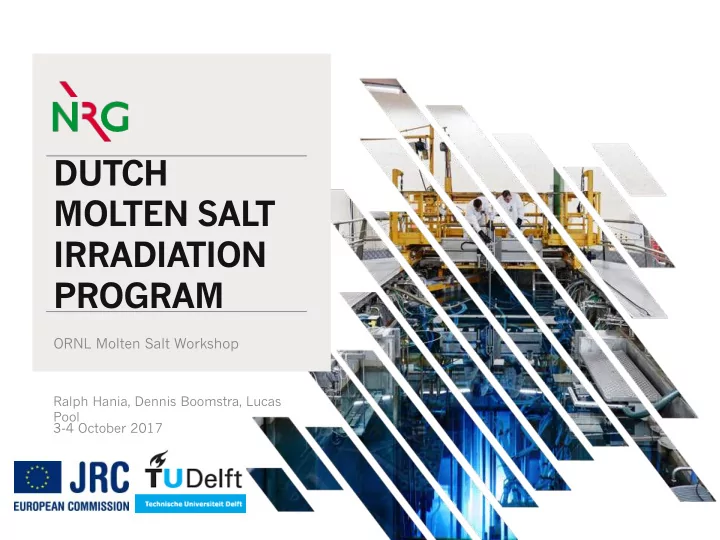

DUTCH MOLTEN SALT IRRADIATION PROGRAM ORNL Molten Salt Workshop Ralph Hania, Dennis Boomstra, Lucas Pool 3-4 October 2017
2 Petten, The Netherlands £ £ Amsterdam
3 NRG-24094/17.144867 - EU DuC=0E001 IRRADIATIONS IN THE HFR PETTEN The High Flux Reactor in Petten is a 45 MW th tank-in-pool reactor used for material research and isotope production (~275 full power days per year) Hoist Pool Reactor core Sub pile room Room for control rod drives
4 NRG-24094/17.144867 - EU DuC=0E001 NRG’S MOLTEN SALT PROGRAM Collaboration between NRG, JRC and TU Delft (soon also CVR Rez, FU Berlin) Complementary competences • Molten Salt Technology fits well within R&D goals Improving safety • Reducing use of resources • Contributing to CO 2 -free energy market • Program Objectives 1. Obtain operational experience 2. Confirm FP stability in the salt 3. Investigate FP management methods 4. Develop in-pile metal/graphite corrosion rig 5. Waste route for spent molten salt fuel 6. Experimental MS loop for the HFR Petten
5 NRG-24094/17.144867 - EU DuC=0E001 TENTATIVE IRRADIATION SCHEDULE Item Goal Target date SALIENT-01 fission product (FP) behavior 2017 room temperature gamma SAGA irradiation / radiolysis 2018 SALIENT-03 in-pile alloy corrosion / FP behavior 2019 SALIENT-04 in-pile helium bubbling 2020 LUMOS loop flowing salt experimental facility SALIENT capsule irradiations in standard in-core HFR facilities • SAGA facility in HFR spent fuel pool • LUMOS loop in HFR pool (adjacent to core wall) •
6 NRG-24094/17.144867 - EU DuC=0E001 SALIENT-01 DESIGN A stack of open crucibles is irradiated in a double containment: Salt composition: 78LiF-22ThF 4 – Single result on cover gas composition for multiple crucibles – Fuel power rises during irradiation due to production of U-233 – Gas composition between containments is adjusted to maintain a fixed crucible – temperature (~600 o C)
7 NRG-24094/17.144867 - EU DuC=0E001 SALIENT-01 ASSEMBLY
8 NRG-24094/17.144867 - EU DuC=0E001 CURRENT STATUS Start of irradiation: • 700 August 10 650 First cycle completed • o C according specifications Temperature 600 31 FPD • Temperatures on target • 550 Average crucible • L1 500 temperatures: L2 L3 585 o C (L1, L4) • L4 450 620 o C (L2, L3) • 0 100 200 300 400 500 600 700 Time (hours) Max. # cycles: 18 •
9 NRG-24094/17.144867 - EU DuC=0E001 POST-IRRADIATION EXAMINATIONS Calibrated burn-up analysis Sample compositions – Neutron radiography of the sample holders Experiment overview, integrity after irradiation – Gamma spectrometry Indication of the spread of gamma-emitting species within sample holder – Puncture of the sample holder and gas analysis by mass spectrometry Fission gas release from samples through natural convection (Xe, Kr, He) – Electron microscopy / WDS: FP distribution over salt, metal filter, graphite wall – Size distribution of metallic species – Surface states of graphite, metallic species – Knudsen cell effusion: Determine salt stability, temperature at which FP species become volatile, Cs – release
10 NRG-24094/17.144867 - EU DuC=0E001 WASTE STRATEGY Conversion of salt to recognizable, acceptable • chemical forms: Oxide high level waste • Cemented intermediate level waste • Fluoride intermediate level waste (CaF 2 or fluorapatite) • Route: aqueous processing • Can be performed at NRG hot cells with relatively little • infrastructure changes No complicated gas streams • Limited spreading of dust • Preliminary lab results: • Dissolution in nitric acid and removal of bulk lithium • Removal of the fluoride by metathesis in KOH • Precipitation of the fluoride using calcium (CaF 2 ) • Calcination of hydroxides to oxides • Cementation of remaining liquid waste •
11 NRG-24094/17.144867 - EU DuC=0E001 SALIENT-03 - CONCEPT A second capsule irradiation, but using Alloy N (or similar) • crucibles Focus on in-pile corrosion à salt buffering (UF 4 :UF 3 ) and electric • heaters needed Crucible corrosion from electron microscopy • Possibly: small samples of the crucible material for weight change • measurements Materials: • Russian-developed formulation HN80MTY [Ignatiev2013], • small batch produced by COMTES FHT in Czech Republic Other (modified) Alloy N types requested for direct • comparison Possibly: SiC •
12 NRG-24094/17.144867 - EU DuC=0E001 SAGA GAMMA IRRADIATION FACILITY HFR Spent fuel used as • gamma source (30-70 kGy/h) ~45 o C base irradiation (solid • salt samples) Possibility for out-of-pool • electric heating to 150 o C à recombination kinetics Samples provided bij CVR • Rez and JRC Karlsruhe
13 NRG-24094/17.144867 - EU DuC=0E001 LUMOS LOOP CONCEPT DESIGN In-pool loop positioned directly next to HFR core wall Main parameters: Actinide bearing FLIBE • salt (~20 L) Alloy N first • containment Power: 125 kW (initial) • Power density: 100- • 180 W/cc Flow rate: ≤ 3 m/s • ∆ T: ≤ 100 o C • 5-6 operational years • targeted
14 NRG-24094/17.144867 - EU DuC=0E001 ACKNOWLEDGEMENTS I. Bobeldijk O. Benes E. Capelli P. Soucek J.L. Kloosterman A.J. de Koning M. Naji A.L. Smith S. de Groot R.J.M. Konings D. Bykov E. de Visser-Tynova E. d’Agata J.D. Bruin A. Booij Goods labeled with to European and national export authorization when exported fran EU DuC (European Dual-use Codification) not equal to ‘N’ are subject om the EU and may be subject to national export authorization when exported to another EU country as well. Even without an EU DuC, or with EU DuC ‘N’, authorization may be required due to the final destination and purpose for which the goods are to be used. No rights may be derived from the specified EU DuC or absence of an EU DuC.
15 RADIOLYSIS Radiolysis is the • cleavage of chemical bonds by radiation (in Saturation the current context: alpha, beta and gamma radiation) G-value / efficiency: From halide salts the • halide gases are produced ( F 2 for Induction time fluorides) Radiolysis in cooled • down irradiated fuel salt due to decay heat
Recommend
More recommend